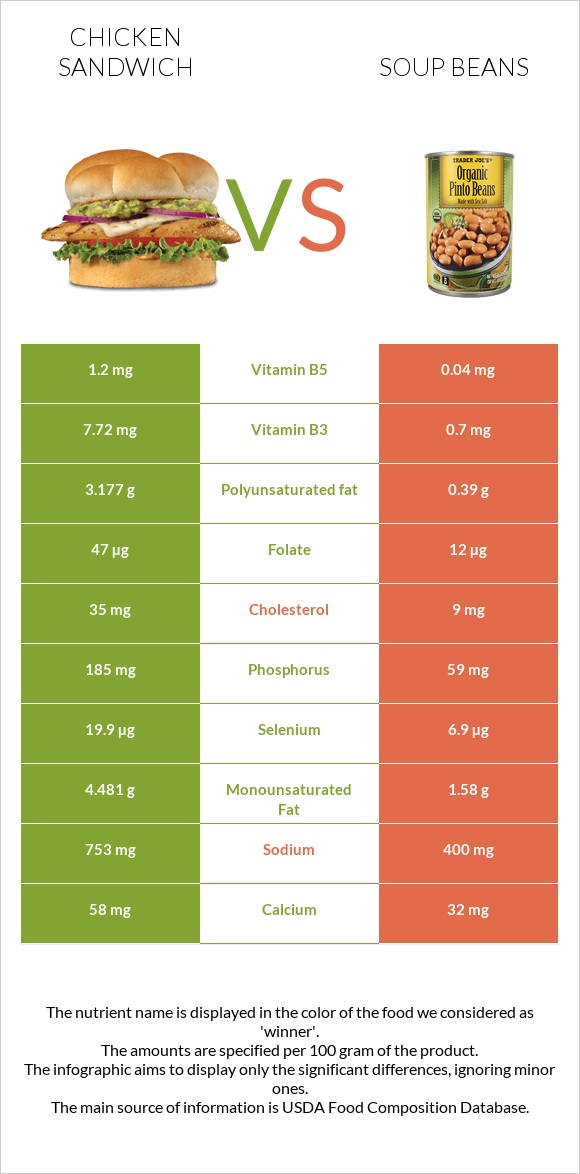Chicken sandwich vs. Soup beans — In-Depth Nutrition Comparison
Compare
How are chicken sandwich and soup beans different?
- Chicken sandwich is higher in vitamin B3, vitamin B6, selenium, vitamin B5, vitamin B2, phosphorus, and vitamin B1; however, soup beans are richer in vitamin A and fiber.
- Daily need coverage for vitamin B3 for chicken sandwich is 44% higher.
- Chicken sandwich contains 30 times more vitamin B5 than soup beans. While chicken sandwich contains 1.2mg of vitamin B5, soup beans contain only 0.04mg.
- Soup beans have less sodium.
Fast foods, chicken fillet sandwich, plain with pickles and Soup, bean with ham, canned, chunky, ready-to-serve are the varieties used in this article.
Infographic

Infographic link
Mineral Comparison
Mineral comparison score is based on the number of minerals by which one or the other food is richer. The "coverage" charts below show how much of the daily needs can be covered by 300 grams of the food.
| Contains more MagnesiumMagnesium | +26.3% |
| Contains more CalciumCalcium | +81.3% |
| Contains more PotassiumPotassium | +40% |
| Contains more IronIron | +33.1% |
| Contains more ZincZinc | +38.6% |
| Contains more PhosphorusPhosphorus | +213.6% |
| Contains more SeleniumSelenium | +188.4% |
| Contains more CopperCopper | +138.8% |
| Contains less SodiumSodium | -46.9% |
| Contains more ManganeseManganese | +32.4% |
Vitamin Comparison
Vitamin comparison score is based on the number of vitamins by which one or the other food is richer. The "coverage" charts below show how much of the daily needs can be covered by 300 grams of the food.
| Contains more Vitamin EVitamin E | +∞% |
| Contains more Vitamin DVitamin D | +∞% |
| Contains more Vitamin B1Vitamin B1 | +283.3% |
| Contains more Vitamin B2Vitamin B2 | +400% |
| Contains more Vitamin B3Vitamin B3 | +1002.9% |
| Contains more Vitamin B5Vitamin B5 | +2900% |
| Contains more Vitamin B6Vitamin B6 | +666% |
| Contains more Vitamin B12Vitamin B12 | +333.3% |
| Contains more Vitamin KVitamin K | +∞% |
| Contains more FolateFolate | +291.7% |
| Contains more Vitamin CVitamin C | +125% |
| Contains more Vitamin AVitamin A | +2600% |
All nutrients comparison - raw data values
| Nutrient |  |
 |
DV% diff. |
| Vitamin B3 | 7.72mg | 0.7mg | 44% |
| Vitamin B6 | 0.383mg | 0.05mg | 26% |
| Selenium | 19.9µg | 6.9µg | 24% |
| Vitamin B5 | 1.2mg | 0.04mg | 23% |
| Protein | 16.28g | 5.19g | 22% |
| Polyunsaturated fat | 3.177g | 0.39g | 19% |
| Phosphorus | 185mg | 59mg | 18% |
| Vitamin B2 | 0.3mg | 0.06mg | 18% |
| Vitamin E | 2.41mg | 16% | |
| Sodium | 753mg | 400mg | 15% |
| Vitamin B1 | 0.23mg | 0.06mg | 14% |
| Fiber | 1.4g | 4.6g | 13% |
| Fats | 11.19g | 3.5g | 12% |
| Copper | 0.067mg | 0.16mg | 10% |
| Cholesterol | 35mg | 9mg | 9% |
| Vitamin A | 3µg | 81µg | 9% |
| Folate | 47µg | 12µg | 9% |
| Calories | 250kcal | 95kcal | 8% |
| Starch | 16.5g | 7% | |
| Vitamin K | 8.5µg | 7% | |
| Monounsaturated fat | 4.481g | 1.58g | 7% |
| Iron | 1.77mg | 1.33mg | 6% |
| Choline | 35.3mg | 6% | |
| Vitamin B12 | 0.13µg | 0.03µg | 4% |
| Carbs | 20.89g | 11.16g | 3% |
| Calcium | 58mg | 32mg | 3% |
| Manganese | 0.219mg | 0.29mg | 3% |
| Saturated fat | 2.123g | 1.37g | 3% |
| Potassium | 245mg | 175mg | 2% |
| Zinc | 0.61mg | 0.44mg | 2% |
| Vitamin C | 0.8mg | 1.8mg | 1% |
| Vitamin D | 5 IU | 1% | |
| Magnesium | 24mg | 19mg | 1% |
| Vitamin D | 0.1µg | 1% | |
| Fructose | 0.97g | 1% | |
| Net carbs | 19.49g | 6.56g | N/A |
| Sugar | 3.64g | N/A | |
| Trans fat | 0.03g | N/A | |
| Omega-3 - EPA | 0.003g | N/A | |
| Omega-3 - DHA | 0.003g | N/A | |
| Omega-3 - ALA | 0.197g | N/A | |
| Omega-3 - DPA | 0.003g | N/A | |
| Omega-6 - Gamma-linoleic acid | 0.009g | N/A | |
| Omega-6 - Dihomo-gamma-linoleic acid | 0.008g | N/A | |
| Omega-6 - Eicosadienoic acid | 0.006g | N/A | |
| Omega-6 - Linoleic acid | 2.884g | N/A |
Macronutrient Comparison
Macronutrient breakdown side-by-side comparison
Protein:
16.28 g
Fats:
11.19 g
Carbs:
20.89 g
Water:
48.94 g
Other:
2.7 g
Protein:
5.19 g
Fats:
3.5 g
Carbs:
11.16 g
Water:
78.63 g
Other:
1.52 g
| Contains more ProteinProtein | +213.7% |
| Contains more FatsFats | +219.7% |
| Contains more CarbsCarbs | +87.2% |
| Contains more OtherOther | +77.6% |
| Contains more WaterWater | +60.7% |
Fat Type Comparison
Fat type breakdown side-by-side comparison
Saturated fat:
Sat. Fat
2.123 g
Monounsaturated fat:
Mono. Fat
4.481 g
Polyunsaturated fat:
Poly. Fat
3.177 g
Saturated fat:
Sat. Fat
1.37 g
Monounsaturated fat:
Mono. Fat
1.58 g
Polyunsaturated fat:
Poly. Fat
0.39 g
| Contains more Mono. FatMonounsaturated fat | +183.6% |
| Contains more Poly. FatPolyunsaturated fat | +714.6% |
| Contains less Sat. FatSaturated fat | -35.5% |





